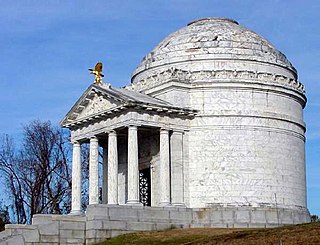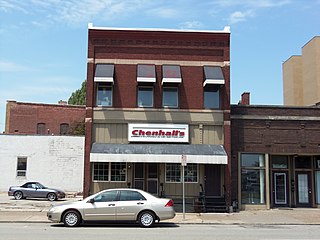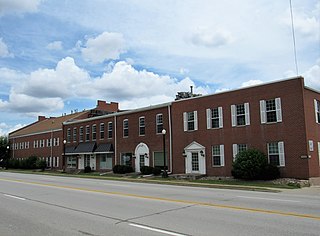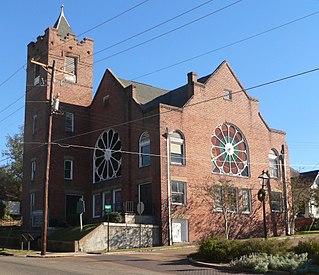
Vicksburg National Military Park preserves the site of the American Civil War Battle of Vicksburg, waged from March 29 to July 4, 1863. The park, located in Vicksburg, Mississippi, flanking the Mississippi River, also commemorates the greater Vicksburg Campaign which led up to the battle. Reconstructed forts and trenches evoke memories of the 47-day siege that ended in the surrender of the city. Victory here and at Port Hudson, farther south in Louisiana, gave the Union control of the Mississippi River.

21 West Street, also known as Le Rivage Apartments, is a 33-story building located in the Financial District of Lower Manhattan in New York City, on Morris Street between West Street and Washington Street. It was built in 1929–1931 as a speculative office tower development in anticipation of an increased demand for office space in Lower Manhattan. The building was converted into apartments in 1997 and was renamed Le Rivage.

The Old Courthouse, Warren County, stands prominently on a hill in Vicksburg, Mississippi, and was a symbol of Confederate resistance during the Siege of Vicksburg. It was designated a National Historic Landmark in 1968 and a Mississippi Landmark in 1986. The landmarked area comprises the entire Courthouse Square, which includes the courthouse and four attached buildings that were originally cistern houses for catching rainwater to fight fires, but these were later converted into offices. Since 1948, it has served as The Old Courthouse Museum, focused on local history and the Confederacy.

Pemberton's Headquarters, also known as the Willis-Cowan House, is a historic house museum at 1018 Crawford Street in Vicksburg, Mississippi. Built in 1836, it served as the headquarters for Confederate General John C. Pemberton during most of the 47-day Siege of Vicksburg. It was also the site where Pemberton surrendered the city to U.S. Major General Ulysses S. Grant on July 4, 1863. The house is owned by the National Park Service and is open to the public as part of Vicksburg National Military Park. The house was declared a National Historic Landmark in 1976.

Hangar One, commonly referred to as Hangar No. 1, is an airplane hangar located on the grounds of Los Angeles International Airport (LAX) in Los Angeles, California. It was listed on the National Register of Historic Places in 1992.
Albert Weiblen (1857–1957) was a German-born American architect and sculptor. His company, the Albert Weiblen Marble and Granite Company, was based in New Orleans and specialized in monuments and burial structures.

Davenport Bank and Trust Company was the leading bank of the Quad Cities metropolitan area for much of the 20th century and for the surrounding region of eastern Iowa and western Illinois. It was once Iowa's largest commercial bank, and the headquarters building has dominated the city's skyline since it was constructed in 1927 at the corner of Third and Main Streets in downtown Davenport, Iowa. It was acquired by Norwest Bank of Minneapolis in 1993 and now operates as part of Wells Fargo following a 1998 merger of the two financial institutions. The historic building was listed on the National Register of Historic Places in 1983 under the name of its predecessor financial institution American Commercial and Savings Bank. In 2016 the National Register approved a boundary increase with the Davenport Bank and Trust name. It was included as a contributing property in the Davenport Downtown Commercial Historic District in 2020. It remains the tallest building in the Quad Cities, and is today known as Davenport Bank Apartments as it has been redeveloped into a mixed-use facility housing commercial, office, and residential space.

Iowa Reform Building is a historic building located in downtown Davenport, Iowa, United States. It was listed on the National Register of Historic Places in 1983 and on the Davenport Register of Historic Properties in 2002.

Shields Woolen Mill is located along the edge of the Mississippi River in Davenport, Iowa, United States. It has been listed on the National Register of Historic Places since 1983. The building has been repurposed as commercial and office space called One River Place.

Peters’ Barber Shop is a historic building located in the West End of Davenport, Iowa, United States. It was completed in 1905 and it has been listed on the National Register of Historic Places since 1984.

Bethel African Methodist Episcopal Church is a historic African Methodist Episcopal (A.M.E.) church located at 805 Monroe Street in Vicksburg, Mississippi. The church was added to the National Register of Historic Places on July 30, 1992; and is listed as a Mississippi Landmark since November 10, 1992.

The Church of the Holy Trinity is a historic church building of the Episcopal Church, built in c. 1870 and located at South and Monroe Streets in Vicksburg, Mississippi.

South Cherry Street Historic District is a historic district in Vicksburg, Mississippi, U.S.. The district is roughly rectangular in shape and includes Cherry Street and Monroe and Drummond Streets, from just south of South Street to Bowmar Street on the south and includes Baum and Chambers streets to Stout's Bayou.

Uptown Vicksburg Historic District is a historic district in Vicksburg, Mississippi, U.S.. The district is bounded by Locust Street, South Street, Washington Street, and Clay Street; also on Washington Streets between Grove and Veto Street; and also roughly bounded by Washington Street, Grove Street, China Street, Clay Street, Locust Street, Veto Street and South Street.

Belle Fleur is a historic house in Vicksburg, Mississippi, U.S.. It is a late Victorian one-story, five-bay galleried cottage built between c. 1872 – c. 1875. It is a National Register of Historic Places listed place since 1992, and is considered a well intact and preserved example of an Italianate-influenced hip-roofed galleried cottage in Mississippi. It is also part of the Uptown Vicksburg Historic District.

Shlenker House is a historic house built in c. 1907 in Vicksburg, Mississippi, U.S.. It is also known as the D.J.Shlenker House, and the Rig Perry House. Shlenker House is a historical reminder of the Jewish immigrant community in Vicksburg during the early-20th century. It is a National Register of Historic Places listed place since 1983; and is listed as a Mississippi Landmark since 2000. The house is also part of the South Cherry Street Historic District. It is an example of early 20th-century eclecticism in architecture in the city of Vicksburg.

The Magnolias is a historic house in Vicksburg, Mississippi, U.S.. It is a two-story, framed Late Victorian style residence built between c. 1877 – c. 1880. It is considered a good example of local architecture and still maintains the "Vicksburg pierced columns" on the exterior. Tours of the home are sometimes available, and has been part of the annual Vicksburg Pilgrimage in the autumn. The residence was once owned by the Vick family, the namesake for the city of Vicksburg.

Hotel Vicksburg, also known as the Vicksburg Apartments, is a historic building in Vicksburg, Mississippi, U.S.. It has been listed on the National Register of Historic Places since June 4, 1979; and is part of a Uptown Vicksburg Historic District since 1993.

Beck House is a historic residence in Vicksburg, Mississippi, United States. It is listed on the National Register of Historic Places since March 29, 1979.

Blum House, also known as Levy House, is a historic residence built in 1902 in Vicksburg, Mississippi, United States. It has been listed on the National Register of Historic Places since July 30, 1992; and part of the Uptown Vicksburg Historic District since 1993.



















